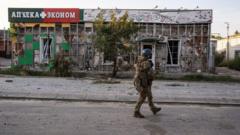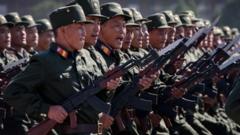A recent cease-fire in Gaza has momentarily halted hostilities, yet the road to lasting peace is fraught with complexities and looming challenges, especially in U.S.-Middle Eastern relations.
Gaza Conflict: Cease-Fire Holds but Challenges Loom Ahead

Gaza Conflict: Cease-Fire Holds but Challenges Loom Ahead
Tensions persist as the Gaza cease-fire introduces uncertainty in Middle Eastern diplomacy.
In the aftermath of a prolonged conflict in Gaza that lasted 15 months, a fragile cease-fire has been established, prompting discussions about the current state of power dynamics in the region. Yahya Sinwar, once a prominent figure leading Hamas, was tragically killed in the conflict; despite this loss, Hamas has reasserted its control, demonstrating resilience even in the face of severe adversity. Thousands of Hamas fighters have emerged from stealth, showcasing their ability to stabilize their position in Gaza without total victory.
Experts like Daniel Levy, a former Israeli negotiator, express concern that Hamas remains a dominant entity in the territory, despite facing substantial challenges. This raises further questions about Israeli Prime Minister Benjamin Netanyahu's political standing, as he grapples with heightened domestic pressures alongside the backdrop of an evolving U.S. administration under Donald Trump.
The current cease-fire, consisting of three distinct phases, reflects a strategic yet fragile agreement, initially outlined by President Biden eight months prior. The delayed commencement of this truce reveals underlying tensions and skepticism regarding its efficacy. Although a path forward has been tentatively laid out, a critical 16-day interval now looms before the initiation of the next phase of discussions.
As peace hangs in the balance, the world watches closely to see if this cease-fire can translate into a more sustainable resolution or if it merely serves as a temporary pause in an ongoing conflict. The future remains uncertain, as leaders on both sides navigate the intricate web of political pressures, global stakes, and the quest for lasting peace.
Experts like Daniel Levy, a former Israeli negotiator, express concern that Hamas remains a dominant entity in the territory, despite facing substantial challenges. This raises further questions about Israeli Prime Minister Benjamin Netanyahu's political standing, as he grapples with heightened domestic pressures alongside the backdrop of an evolving U.S. administration under Donald Trump.
The current cease-fire, consisting of three distinct phases, reflects a strategic yet fragile agreement, initially outlined by President Biden eight months prior. The delayed commencement of this truce reveals underlying tensions and skepticism regarding its efficacy. Although a path forward has been tentatively laid out, a critical 16-day interval now looms before the initiation of the next phase of discussions.
As peace hangs in the balance, the world watches closely to see if this cease-fire can translate into a more sustainable resolution or if it merely serves as a temporary pause in an ongoing conflict. The future remains uncertain, as leaders on both sides navigate the intricate web of political pressures, global stakes, and the quest for lasting peace.























